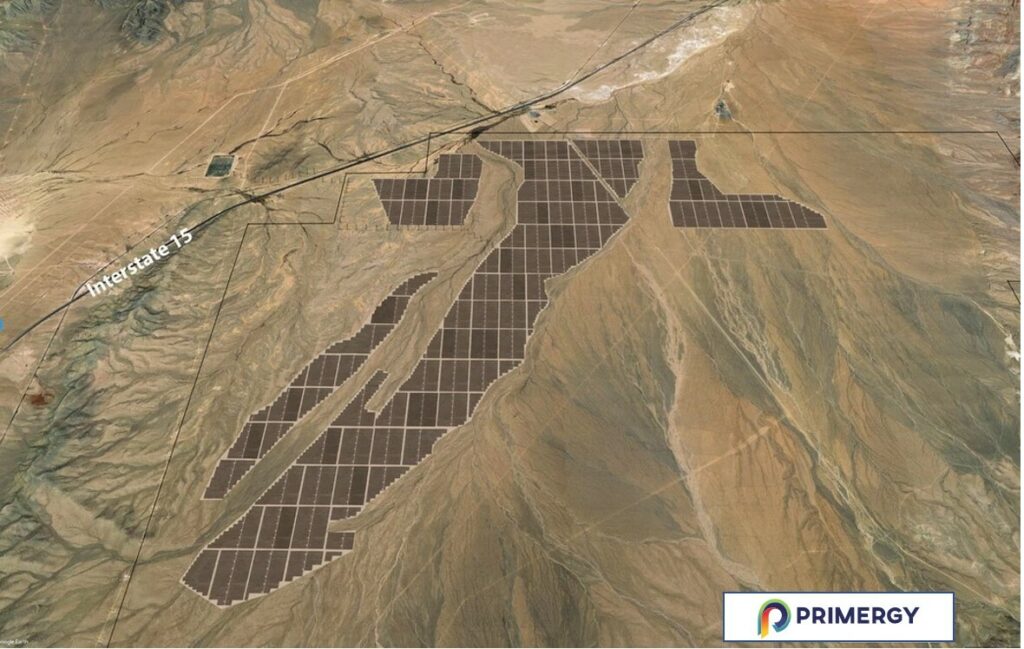Rendering of Gemini project aerial view issued in 2019. Image: Primergy.
Debt and equity financing worth US$1.9 billion has been closed for Gemini, one of the US’ largest single-site solar-plus-storage power plants to date.
Investment manager Quinbrook Infrastructure Partners and project developer Primergy said yesterday that the deal has been clinched for Gemini, which combines 690MWac/966MWdc of solar PV with 380MW/1,416MWh of battery storage, set for construction in Clark County, Nevada.
Scheduled to go into operation in late 2023, power from the plant will be sold to Nevada utility NV Energy under a 25-year power purchase agreement (PPA) contract.
It extends an existing partnership between Primergy and the Berkshire Hathaway-owned utility, with the pair having contracted for 1.3GWac of solar and 3.33GWh of battery storage to date.
In early March, Primergy – which is owned by Quinbrook – announced the appointment of key contractors, including EPC Kiewit Power Constructors and battery energy storage system (BESS) integrator IHI Terrasun, as reported by Energy-Storage.news.
Gemini’s bifacial PV modules will be supplied by Maxeon.
The project’s BESS will be DC-coupled and charge only from the onsite solar PV, IHI Terrasun’s president Jamal Burki told Energy-Storage.news in an interview.
Describing the Gemini project as a “real milestone” for the industry in terms of its scale, Burki said the power plant will enable “continued renewable energy usage” for NV Energy, beyond the hours in which solar is generating during the day.
“This is a four-hour [duration] system, and really a solar shifting application for the evening. The solar system is being oversized so all that ‘clipped’ energy is stored in the energy storage system and will now broaden that solar energy availability into the evening hours, by four hours,” Burki said.
The financing deal just closed includes US$1.3 billion in debt financing, from a combination of a construction/term loan, tax equity bridge loan and letter of credit facility.
Lead arrangers on the construction facility are KeyBanc Capital Markets, MUFG, Bank of America and Norddeutsche Landesbank Girozentrale, while the debt deal also covers a US$95 million mezzanine debt facility from Voya Investment Management.
US$532 million of tax equity financing has also been secured from Truist Bank and Bank of America.
The US’ largest solar-charged battery storage system already in operation is utility Florida Light + Power’s 900MWh Manatee project, while in California developer Terra-Gen is building Edwards Sanborn, which has a planned final capacity of 760MW of PV and 2,445MWh battery storage, albeit that project is being built up in phases, with multiple off-taker contracts.
Supply chain challenges unlikely to impact project
Quinbrook managing partner David Scaysbrook said that many challenges had been “overcome along the way,” in getting the project to this stage.
“Once operational, Gemini will showcase the many benefits of pairing large scale solar power with storage and will guide the way for many similar projects to come from the Primergy team,” Scaysbrook said.
With suppliers and contractors now secured as well as financing, construction is now ready to begin on the “unprecedented” project, Primergy CEO Ty Daul said.
One of the major challenges facing the energy storage industry is the battery supply chain, which has seen bottlenecks and delays, as demand far outstrips supply. IHI Terrasun’s Jamal Burki told Energy-Storage.news that to his knowledge, Primergy was able to lock in contracts with its suppliers early enough to not be expecting any substantive impacts from that market dynamic.
The fact that there are a number of financiers (“almost a consortium”) on the project has derisked it somewhat from a financial perspective too, Burki said. It is worth noting that in 2019 as the PPA with NV Energy was announced, Primergy said Gemini was expected to cost about US$1 billion but would be worth US$2 billion in PPA revenues over the 25-year term. Additionally, as it revealed the contractors in March, the project’s cost was quoted at around US$1.2 billion by the developer.
Continue reading










